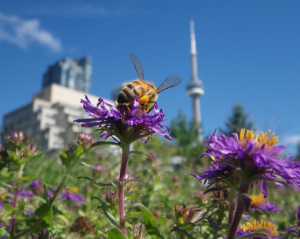Are you curious about the current state of pollinators in the city and how this has changed the last 70 years? Are you curious to learn more about pollinators and their preferences for habitats and vegetation? Would you like to explore rural parts of the city in search for bees, bumblebees and hoverflies? Then this is the project for you!
 Project description
Project description
While urbanization is increasing, green spaces are decreasing. The habitat loss and fragmentation of urban vegetation cause a major threat to biodiversity, pollinators and other insects included. When pollinators decline – so does the predators that feed on them, the plants that depend on pollination and the eco-system services that pollinators provide. This will in turn affect air quality, mental health, green jobs – and eventually, me and you. These are just some of the reasons why it is important to protect the pollinators from further decline.
The project will be conducted in Bergen city and surrounding area, with an emphasis on spots that contains various natural and/ or human induced vegetation. The areas of interest will include green spaces such as parks, cemeteries, gardens, meadows and forest edges. This framework will hopefully provide us with great diversity and abundance of winged pollinators. We will also examine the explanatory variables between sites, such as plant diversity and abundance. The results will then be compared to Astrid Løken’s collection of bumblebees in Bergen between 1950-1978, to see which factors may have contributed to any changes.
The durability of the field work is set to 3 weeks, and occurs at the end of June, July and August – but this is subject to change, as the surveys are weather dependent.
Tasks
In order to examine the pollinators thoroughly, we need to take them back to the lab for further processing. The student will take part in mounting and dismounting traps, and doing lab tasks such as rough sorting of the specimens.
Depending on the students whereabouts during work hours, there may be travel expenses to/ from the field site and to/ from the lab. We’ll be using a rental car for the field work so most likely the travel can be arranged by pick-up in this part of the project.
The project involves: Labwork & Fieldwork
Starting date/period: June 20th – September 1st 2022.
Experience: The student will gain skills in handling insect traps and specimens. You may learn a thing or two about time management and more extensive species identification, how to do lab work and how to work as a scientist.
Involvement: Preferably 2 times a week for fieldwork (every 4th day) until the end of August, then occasional lab work from August until September (and maybe some during the summer) – to a max. of 40h per student.
Interested by this project? Need more info? Contact Ingrid Vaksvik (iva032@uib.no)
Project number: 041
